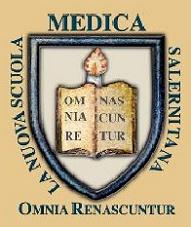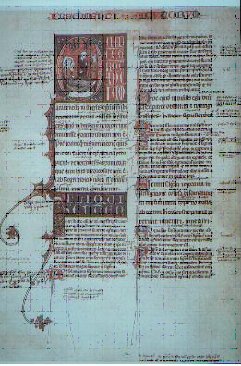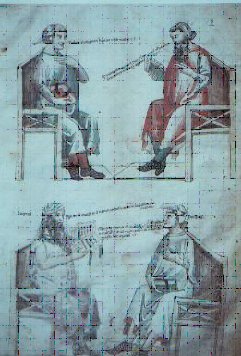The origins, the golden period of one of the most important
Medieval Medical Institutions in the West: The Salerno Medical School
At the School with the Salernitan Masters
The origins of the School
The origins of the Salerno Medical School go back to the beginning of the medieval age. Legend attributes its foundation to four doctors, the Hebrew Helinus, the Greek Pontus, the Arab Adela and the Latin Salernus, epitomizing that the Ars medica of Salerno was born from the confluence of these four cultures ( Kristeller, 1986).
The geographical position of Salerno, at the centre of the Mediterranean area, gave the city a primary position in important trading whit the Orient and Africa, mediated through Amalfi and Sicily.
The phenomenon of the Benedictine monasteries, that began in Montecassino, was yet another contribution to the growth of scientific studies and medical practice in Salerno, where the Abbey of Saint Benedict was founded.
Fig. 1. Florence. Laurenziana Library, Ms Gaddi 24, f 247 v. This picture shows that the Salerno Medical School was more than just a teaching school and had its own first aid unit and perhaps, its own hospital system. This made it possible to keep patients in for observation in order to establish which therapies best suited the different aliments.
The art of medicine was enriched thanks to the activities that took place in the infirmaries of the monasteries, and the work of lay doctors, some of whom were women. These doctors practised their profession initially empirically on their own and later through associations with speculative and didactic hypotheses.
The first historical mention of the SMS goes back to the 10th century, being quoted in such different books of the age as Historia inventionis ac traslationis et miracula S. Trophimenae, in Chronicon by Hugone of Flavigny and in the Historia by Richeiro of Reims (Oldoni, 1988).
The first document in which the School is mentioned as an institution, is found in the Constitution of Federico II, published at Melfi in 1231, when the SMS was declared to be the only medical school in the Kingdom (Sinno, 1950).
In 1290, the School received from Carlo I its first stature, which was recognized as “ Studium generale” in medicine. The School’s activities continued throughout the centuries until 1811 when, with the reorganization of “public instruction” in the Kingdom, Gioacchino Murat conferred the faculty of awarding degrees exclusively to the University of Naples (Musi, 1988).
The Doctors of the 11th Century
The first literary production of the SMS goes back to the 11th century and originates from the classical and late- ancient tradition based on the knowledge of some practical and pharmacological textbooks by Galen, Pliny, Dioscorides, Celius Aurelianus, Teodoro Prisciano, Paolus Eginata, Alessandra Trallianus and on the humoral Hippocratic-galenic doctrines (Beccaria, 1956). Alfano, in his books De quattuor humoribus (Capparoni, 1928) and De pulsibus (Capparoni, 1936) resuscitated the ancient theories that explained illness on the basis of a lack of equilibrium of the four humours (that is the liquids) inside the human body: blood, bile, phlegm (secretion of the nasal fossae, thought to come from the brain), and black bile (thought to come from the spleen). Therapies adopted to rebalance the equilibrium utilized diagnostic elements derived from urine, fever and pulse examinations.
This inheritance from the past was systematically put into handbooks which required the didactic need to transmit medical knowledge. The first example is Passionario by Garioponto, a compilation of texts of various authors (De Renzi,1857). The illnesses of the human body are described systematically in 251 chapters as are their various cures, derived from the vegetable world. The preparation of these medicines and the properties of the various components were studied in numerous handbooks, such as the Liber dynamidios, attributed, although not unanimously, to Garioponto (Giacosa, 1901).
These first works revealed a greater interest in medical practice than in general theoretical problems, as evident in De mulierum passionibus, a gynaecological and obstetric handbook attributed to Trocta, a famous female doctor of Salerno, better known as Trotula. In this book all the disorders of the female are tackled by means of practical advice, which reveals a subtle, psychological approach of exquisite sensitivity (Cavallo Boggi, 1979).
Costantino Africano
The School’s knowledge was enriched with new perceptions in the 11th century, when Costantino Africanos’s work spread: he was the first promoter of Islamic medical science in the West.
After a life of studying and travelling that took him to Persia, Arabia and Spain, in the second half of the 11th century he went to Montecassino. Here he dedicated himself to the translation of numerous textbooks of classic, Hebrew and Islamic medicine, such as the writings of Isacco Giudeo on urine, diet and fever; the Isagoge and De oculis by Johannitius; Aforismi, Pronostici, and a textbook on acute illnesses of Hippocrates and Arsa parva and other works by Galen (Diacono, cod. cas. 361). (Figure 2)
Fig. 2. Vienna, Osterreichische National Bibliothek.
Cod 2315. F 100 v. Writings of Hippocrates and Galenus translated by Costantino Africano.
The spread of these translations increased interest in the doctrines of Aristotle, which were the foundations of these works, thus helping to bring about the birth of the philosophy called “scholastic” (Sigerist, 1923).
But, above all it was in the pharmacological field that the School felt the influence of Costantino’s works: his translation of Kitab-al-maliki by Ali-ibn-Abbas, one of the most important texts of Arabic medicine known as Pantegni, enriched the handbooks on Salernitan remedy with a wide range of prescriptions, unknown until then (De Martino, 1988).
The Doctors of the 12th Century
The most interesting period in the School’s history is the 12th century, which is rich whit pathological and therapeutic manuals. The first example is Liber aureus by Giovanni Afflacio, a disciple of Costantino and his principal promoter ( Pasca, 1988).
The doctors at this time did not completely favour the ancient theories, but reviewed and annotated them, and assumed a much more critical attitude in their comparisons.
The works of this period are characterized by a greater interest towards general theoretical principles, even though the practical intentions and the didactic objectives remained basic: an example is the manual Practica by Bartolomeo, at that the most important book on general pathology ( De Renzi, 1852-1859). (Fig. 3)
Fig. 3. Paris, National library, Ms 6823. Master Bartholomeo reads the verses of his Practica
By this time, the ancient theories were part of the culture of doctors whose personalities stand out in the scientific world of the culture of doctors whose personalities stand out in the scientific world of the 12th century; there are names such as Maestro Ferrario who wrote Curae, Maestro Salerno who wrote a series of exhaustive books (Catholica, Compendium, Tabulae) on diagnosis and treatment; and Nicolò Salernitano with his Antidotario, a work on pharmacological therapy widely used at the School (Kristeller, 1986).
Due to the slow absorption of Costantino’s translations, the knowledge of Arabic medicine gradually contributed to the intellectual development of the masters which produced a new literary form of Commentarium, within which in perfect equilibrium are blended the old theories and the doctrines suggested by new experience (De Renzi, 1857).
A new type of teaching began, based on lectures and comments on prestigious texts, a great interest grew for philosophical and theoretical questions and for Aristotel’s doctrines.
Salernitan teaching developed an effective “Curriculum” based on studies of classical texts published in the 15th and 16th centuries, under the name of Articella, and these constituted the foundation of the study of medicine until the 18th century (Kristeller, 1986).
Regimen Sanitatis
The rules of hygiene dictated by the School formed the basis of its doctrines, and were widely diffused as the result of Regimen sanitatis salernitanum the work largely responsible for Salerno’s reputation( figure 4). The origin of this work is not definitely known (De Renzi, 1857), but appears to be the result of a collective work produced from popular practice and annotated by Arnaldo of Villanova in the 13th century. This corpus grew over the years to such a degree that the 362 verses of the first printed edition in 1479, became 3520 in the last edition (Alfinito,1988 ).
Once dedicated to an “Anglorum Regi” (probably Robert of Normandy), but at other times to a “Francorum Regi”, these dedications, if authentic, would help to define the exact date of the work (Oldoni, 1988). (Figure 5)
Although not a true medical handbook, it was used as such for centuries, being written in such a way that it could be easily remembered. In leonine verses, it contained a remedy for every occasion and advice for remaining healthy.
The summa of the Salernitan teaching is condensed into the first verses which suggest a remarkably healthy and tranquil way of life.
The Salernitan School unanimously wrote to the King of England:
If you want to be well, if you want to be healthy
Expel grave thoughts, to get angry is harmful.
Drink a little, eat soberly; it will not be in vain
get up after lunch; shun the afternoon nap;
don’t hold urine, don’t restrain your abdomen for too long;
if you observe these rules faithfully, a long time you will live.
If you are in need of doctors, for you these three things
will be doctors: a merry soul, tranquillity and a moderate diet.
(Sinno, 1987).
As is the Salernitan tradition, Regimen contained a reference book to exploit the medicinal properties of the official plants.
Even the epilogue is a further encouragement to follow the principles adumbrated, their validity being assured by being dictated by Ursone and Matteo, doctors “ per quos regnat Medicina Salerni”(Sinno, 1987).
Fig. 4. Liber De Rigimine Sanitatis. Naples, National library, Ms XIII C, 37 (ff 51-69).
The short poem has been written in a cultured Neapolitan dialect, mixed with medieval Latin and Tuscan.
The Regimen sanitatis salernitanum is well embodied in the literary stream of tacuina and of theatra sanitatis; works of an encyclopaedic character in which, next to illustrations of the elements of nature, there are illustrations of foods, state of mind, and seasons, whith the aim of maintaining good health by means of a perfect equilibrium between Man and Nature.
Fig. 5. Avicenna, Canon Maior, 14th- 15th centuries, Bologna, Universitary Library, Ms 2197, f 317 v. This picture shows a miniature that appears in manuscript 2197 of the Canone of Avicenna, which provides the only authentic, albeit idealized, image of the Salerno Medical school within complex environmental framework. The illustration portrays a town full of towers, closed within walls which overlook a gulf broken by numerous inlets and used by shipping. The picture shows Robert, Duke of Normandy, who asks the doctors on his departure for a vade mecum, a volume containing the basic principles of the ancient Hippocratic art of Salerno. Thus arose the Dedica of the Regimen Sanitatis to the king of the Angles. The year is 1103. In the left of the picture we see Sibilla of Conversano, wife of the Duke, who is dying, having sacrificed herself by sucking the poison from her husband’s arm while he was asleep.





